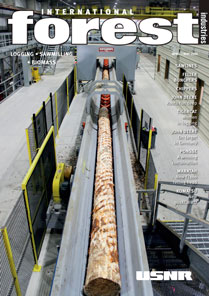EDITOR’S COMMENT Issue 76
Forestry post-COVID looks ‘greener’
When I left off last time, I was speculating on the shape of a recovery and, from memory, I believe I was hedging my bets and suggesting we were tracking for a reality somewhere between a best-case, V-shaped recovery and a prolonged lockdown period followed by a deep recession and slow recovery.
Where in between these points we ended up would depend almost entirely, I (most people?) thought, on the speed at which a vaccine could be developed and distributed.
It is therefore pleasing to be writing this column following the positive trials for not one, but a handful of vaccines – in all, there are apparently more than 150 vaccine efforts cooking globally. The most successful of these is a source of pride for our little organisation, given it originates from Oxford University, which is just a stone’s throw (albeit a long stone’s throw) from our UK offices. If the breathless mainstream press can be trusted, a vaccine could be ready for distribution to the most vulnerable by Christmas – fantastic news indeed.
At the same time, we have seen positive signs out of China – the world’s growth engine for the past almost two decades and the world economy’s saviour immediately following the last financial crisis that gripped us in 2008-2009.
China’s GDP grew 3.2% year-on-year in the second quarter, reversing from a 6.8% drop in the March quarter. No other nation does stimulus better than China and, though a sharp focus has turned to the Communist Party of China’s geopolitical agenda and many governments have displayed misgivings over China’s role as the source of the pandemic, history shows self-interest will prevail and China will quickly re-establish trade relationships, even if the negotiations are fraught. Wood Resources International recently reported that German log and lumber exports set new records in 2020, with half of the 2.4 million m3 moved heading to China in the four months to April.
Other large economies may be weighed down – namely the US – but with resilience and growth in other parts of the world, there must be hope that, with a vaccine close, even the most troubled economies can see light (and the US has only been outbought on orders from Oxford by the UK).
Whether or not this means a V-shaped recovery is uncertain. But, from where I’m sitting, it’s tough to see it getting any worse for the forestry sector.
Much like in 2008-2009, primary industry is usually valued far more in times of economic crisis than when the world is booming. Sure, tech stocks might sound cool when you’re talking to your friends at the pub, but when push comes to shove, people prefer tangible assets that hold genuine value.
Also, again like the last crisis (and many before it), governments are planning to build their way out of trouble with infrastructure projects the like most would not have seen – and will not see again. These are planned across the first world and parts of the developing world. Forestry, as a supplier of construction materials, will of course benefit from these.
And, finally, governments have bought into sectors to hold stakes in private businesses at levels not seen since the Second World War. These rescue missions and resulting influence means politicians will now set much of the business agenda. Do not be surprised, therefore, to see political issues such as climate change and environmentalism in general being pushed through businesses at a far faster rate than previously thought possible. Business will have to comply or forfeit their aid – think recyclable building materials and biomass energy.
So, while the world remains an uncertain place, I’m feeling much more confident writing this column than I was in April, or indeed June. And you should be, too.
Enjoy
Chris Cann







